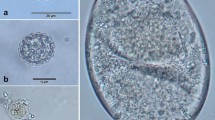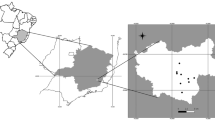Abstract
Background
Giardia duodenalis and Entamoeba spp. are among the most common intestinal human protozoan parasites worldwide and they are frequently reported in captive non-human primates (NHP). From a public health point of view, infected animals in zoos constitute a risk for animal caretakers and visitors. In this study we carried out the molecular identification of G. duodenalis and Entamoeba spp. from nine species of primates housed in the zoological garden of Rome, to better ascertain their occurrence and zoonotic potential.
Results
G. duodenalis was found only in Lemur catta (47.0%). Entamoeba spp. were detected in all species studied, with the exception of Eulemur macaco and Varecia rubra. The number of positive pools ranged from 5.9% in L. catta to 81.2% in Mandrillus sphinx; in Pan troglodytes the observed prevalence was 53.6%. A mixed Entamoeba-Giardia infection was recorded only in one sample of L. catta. All G. duodenalis isolates belonged to the zoonotic assemblage B, sub assemblage BIV. Three Entamoeba species were identified: E. hartmanni, E. coli and E. dispar.
Conclusions
Our results highlight the importance of regularly testing animals kept in zoos for the diagnosis of zoonotic parasites, in order to evaluate their pathogenic role in the housed animals and the zoonotic risk linked to their presence. A quick detection of the arrival of pathogens into the enclosures could also be a prerequisite to limit their spread into the structure via the introduction of specific control strategies. The need for molecular identification of some parasite species/genotype in order to better define the zoonotic risk is also highlighted.
Similar content being viewed by others
Background
Protozoa are the most common parasites in captive non-human primates (NHP). Amongst others, Giardia duodenalis and Entamoeba spp. are frequently reported [1–3]; the simplicity of their monoxenous life cycle, the low infective dose and the short prepatent period facilitate their dispersal among captive animals once they have entered the enclosures (cages, pens, etc.) [4, 5].
The relevance of Giardia and Entamoeba infections in zoo animals goes beyond their clinical effects. From a public health point of view, these protozoa have high zoonotic potential, being among the most common intestinal human parasites worldwide [6–8]. Infected NHP in zoos constitute a risk for animal caretakers [9, 10] and possibly people visiting the zoological gardens. On the other hand, infected people could be the source of infection for the captive NHP via water and/or food contamination. Hence, the epidemiological relevance of gaining a better understanding of the transmission patterns of these pathogens in and from zoo facilities.
From a management point of view, new threats have arisen in the last few years due to the tendency to reproduce habitats as similar as possible to the natural ones. In particular, the removal of the cement as flooring and the use of distributing food mixed in the litter to elicit natural seeking behaviours, has facilitated faecal contamination and made disinfection of cages and pens very difficult, resulting in the creation of habitats suitable for parasite survival and transmission.
G. duodenalis is known to provoke gastrointestinal disorders in NHP [10, 11]. This species includes at least seven genotypes or assemblages (A→G), assemblages A and B being detected both in humans and NHP [12, 13]. Regarding the genus Entamoeba, in a recent study [14] six species (E. histolytica, E. dispar, E. moshkovskii, E. hartmanni, E. coli and E. polecki-like organisms) were recorded in captive NHP in Belgium and The Netherlands. The clinical relevance of Entamoeba spp. is more difficult to ascertain in NHP. Several species are considered non-pathogenic, while E. histolytica and its virulent variant E. nuttalli are known to provoke severe and sometimes lethal intestinal and extra-intestinal disorders in monkeys and apes [2, 15–17]. Problems arise in E. histolytica diagnosis, because of the impossibility via conventional microscopy to distinguish between this species and the non-pathogenic E. dispar and E. moshkovskii. Hence, in the presence of a copro-parasitological diagnosis of amoebiasis, there is justification for using PCR to rule out infection with the pathogenic and potentially lethal species [18–21].
In the literature, there is no data regarding intestinal protozoa occurrence and molecular identification in NHP from Italian zoos. Following detection of G. duodenalis and Entamoeba spp. during routine copro-parasitological examinations, a study was carried out aimed at the molecular identification of G. duodenalis assemblages and Entamoeba species in NHP housed in the zoological gardens of Rome, to better define their presence and to understand their zoonotic potential.
Methods
Study site and Sampling
The Bioparco is one of the oldest zoological gardens in Europe, founded in 1911. It is located in the city centre of Rome (Italy), covering an area of 18 ha and housing about 1000 specimens belonging to almost 200 species comprising mammals, birds and reptiles. It was designed in accordance with the new concept of "Zoo without bars" to improve animal welfare. Animals live in large spaces with reconstruction of the natural habitats suitable for each species. To avoid contact with people, glass screens or ditches border animal cages and pens.
Nine species and 3 families of NHP were involved in this study, the families being: Lemuridae (prosimians), Cercopithecidae (Old Word monkeys) and Hominidae (apes) (Table 1). At the Bioparco, monkeys and apes are kept in monospecific groups of 2-98 individuals sharing the same pens. All NHP are housed in cages and pens littered with natural materials such as ground bark and they are fed mixing the food with the litter.
Due to the group housing, copro-parasitological analysis was performed on pools of faeces collected from the litter, with the exception of P. troglodytes, where individual sampling was possible.
Coprological examination
All the samples were sent to the laboratory of Parasitology of the IZSLT for routine copro-parasitological diagnosis. Faecal samples were examined for parasitic protozoa cysts and/or trophozoites using the wet mount Lugol's iodine staining method and the formol ethyl-acetate concentration technique [22, 23]. In case of ambiguous results obtained using microscopy, G. duodenalis infection was confirmed via a commercial immunofluorescence kit, (MERIFLUOR®Cryptosporidium/Giardia, Meridian Bioscience, Inc.).
Samples positive for G. duodenalis or Entamoeba spp. cysts were transferred to the University of Rome Tor Vergata for molecular characterization.
Molecular analysis and sequencing
Genomic DNA was extracted from faecal samples using the QIAamp DNA Stool Mini Kit (Qiagen, Italy) following manufacturer's instructions. Molecular analysis was carried out by amplifying an 18S rRNA genus fragment both for G. duodenalis and Entamoeba spp.
For Giardia, a nested PCR procedure was performed to amplify a 130 bp region using the primers RH4 and RH11 [24] for the first step and the primers GiarR and GiarF in the second amplification round [25].
The amplification of the specific fragment of Entamoeba spp. was obtained using the primers JVC and DSPR2 [26], which are also able to detect the virulent variant of E. histolytica, E. nuttalli, observed in NHP [17]. The amplicons were from 622 to 667 bp long depending on the species.
To confirm Giardia 18S rRNA genetic identity of the samples, an additional analysis was performed by sequencing the triose phosphate isomerase (tpi) and glutamate dehydrogenase (gdh) loci. To amplify the tpi fragment, a nested PCR procedure was used to obtain a 530 bp region using the primers AL3543 and AL3546 for the first step and AL3544 and AL3545 for the second one [Full size table
Sequences obtained were identified at the 18S-rRNA locus as assemblage B, by comparing to GenBank sequences of Giardia genotypes (Accession Numbers: AF199446 (assemblage A), AF199447 (assemblage B), AY775200 (assemblage C), AY775199 (assemblage D), AY297957 (assemblage E), AF199444 (assemblage F) and AF199450 (assemblage G). The bootstrap consensus trees for both gdh and tpi genes obtained by NJ method yielded one monophyletic group corresponding to the assemblage B, sub assemblage BIV which included Giardia sequences from L. catta (Figure 1). Mixed assemblages, showing double peaks at the diagnostic positions at the three loci in the chromatograms, were not observed. Consensus trees obtained by the phenetic analysis confirmed this result.
Phenetic relationships of G. duodenalis inferred by NJ analysis of the gdh (a) and tpi (b) loci. Only bootstrap values > 70 are indicated. The Accession Numbers utilized for gdh were L40509 (AI), L40510 (AII), AF069059 (BIII), DQ090539 (BIII-like), L40508 (BIV), DQ090532 (BIV-like) and those ones for tpi were AF069556 (AI), AF069557 (AII), AF069561 (BIII), AY228632 (BIII-like), AF069560 (BIV), AY228634 (BIV-like).
Amplification of the 18S-rRNA Entamoeba genes
The results revealed the presence of Entamoeba DNA in 45 out of 64 samples. In total three Entamoeba species were identified: E. hartmanni (31.1%), E. coli (31.1%) and E. dispar (20.0%) (Table 3). The assignment of the Entamoeba species within the hosts is reported in the constructed phenetic tree (Figure 2). No mixed infections were detected. Non-interpretable sequences were obtained from 8 of the amplified samples, but showed homology to Entamoeba spp. For 4 samples, DNA amplification was unsuccessful; for 15 sequences homology was found to DNA sequences from plants, ascomycetes and zygomycetes (Malus domestica, Pyrus communis, Sordaria fimicola, Neurospora crassa, Helicostylum pulchrum, Sporodiniella umbellata).
Phenetic relationships of Entamoeba spp. inferred by NJ analysis of the 18S rRNA genus. Only bootstrap values > 70 are indicated. The Accession Numbers utilized for the identification of Entamoeba spp. were AB282657 (E. nuttalli), X65163 (E. histolytica), AB282661 (E. dispar), AB444953 (E. coli), AF149907 (E. hartmanni), AF149906 (E. moshkoskii), AF149913 (E. polecki-like variant 1) and AF149912 (E. polecki-like variant 4).






